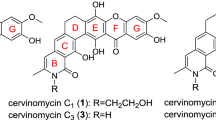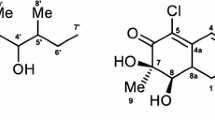Abstract
Bioassay-guided fractionation of CHCI3 extract from the fermentation broth of a spongeMycale plumose-derived actinomyceteSaccharopolyspora sp. nov., led to the isolation of two known prodigiosin analogs - metacycloprodigiosin (1) and undecylprodigiosin (2). These compounds exhibited significant cytotoxic activities against five cancer cell lines: P388, HL60, A-549, BEL-7402, and SPCA4. This is the first report on the significant cytotoxicity of metacycloprodigiosin (1 ) against human cancer cell lines.
Similar content being viewed by others
References
Ricardo, P. A., Beatriz, M., Esther, L, and Vanessa, S. C, The prodigiosins, proapoptotic drugs with anticancer properties.Biochem. Pharmacol., 66,1447–1452 (2003).
Furstner, A., Grabowski, J., Lehmann, W., Kataoka, T. T., and Nagai, K., Synthesis and biological evaluation of nonylpro-digiosin and macrocyclic prodigiosin analogues.Chem. Bio. Chem., 2, 60–68 (2001).
Nakamura, ?., Nagai, K., Ando, K., and Tamura, G, Selective suppression by prodigiosin of the mitogenic response of murine splenocytes.J. Antibiot., 39, 1155–1159 (1986).
Spongia, S., Mortellaro, ?., Taverna, S., Fomasiero, C., Sheiber, E. A, Erba, E., Colotta, F., Mantovani, A., Isetta, A. M., and Golay, J., Characterization of the new immunosuppressive drug undecylprodigiosin in human lymphocytes: retinoblastoma protein, cyclin-dependent kinase-2, and cyclin-dependent kinase-4 as molecular targets.J. Immunol., 158, 3987–3995 (1997).
Matsuya, H., Okamoto, M., Ochi, T, Nishikawa, A., Shimizu, S., Kataoka, T, Nagai, K., Wasserman, H. H., and Ohkuma, S., Reversible and potent uncoupling of hog gastric (H+ + K+)-ATPase by prodigiosins.Biochem. Pharmacol., 60, 1855–1863 (2000).
Sato, T, Konno, H., Tanaka, Y, Kataoka, T., Nagai, K., Wasserman, H. H., and Ohkuma, S., Prodigiosins as a new group of H+/Cl- symporters that uncouple proton translocators.J. Biol. Chem., 273, 21455–21462 (1998).
Skehan, P., Storeng, R., Scudiero, D., Monks, ?., McMahon, J., Vistica, D., Warren, J. T, Bokesch, H., Kenney, S., and Boyd, M. R., New colorimetric cytotoxicity assay for anticancer drug screening.J. Natl. Cancer Inst, 82,1107–1112 (1990).
Wasserman, H. H., Rodgers, G. C, and Keith, D. D., Metacyclo-prodigiosin, atripyrrole pigment fromStreptomyces longisporus ruber.J. Am. Chem. Soc, 91,1263–1264 (1969a).
Author information
Authors and Affiliations
Corresponding authors
Rights and permissions
About this article
Cite this article
Liu, R., Cui, CB., Duan, L. et al. Potentin Vitro anticancer activity of metacycloprodigiosin and undecylprodigiosin from a sponge-derived actinomyceteSac-charopolyspora sp. nov.. Arch Pharm Res 28, 1341–1344 (2005). https://doi.org/10.1007/BF02977899
Received:
Issue Date:
DOI: https://doi.org/10.1007/BF02977899




